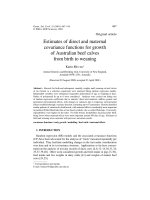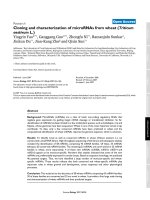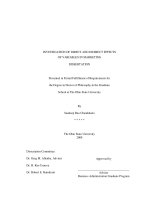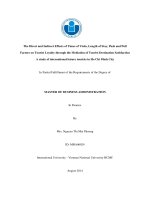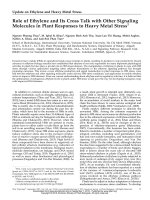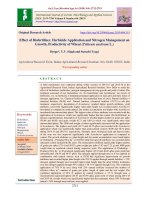Estimates of direct and indirect effects along with correlation coefficient analysis in bread wheat (Triticum aestivum L.)
Bạn đang xem bản rút gọn của tài liệu. Xem và tải ngay bản đầy đủ của tài liệu tại đây (287.48 KB, 11 trang )
Int.J.Curr.Microbiol.App.Sci (2019) 8(1): 986-996
International Journal of Current Microbiology and Applied Sciences
ISSN: 2319-7706 Volume 8 Number 01 (2019)
Journal homepage:
Original Research Article
/>
Estimates of Direct and Indirect Effects along with Correlation Coefficient
Analysis in Bread Wheat (Triticum aestivum L.)
Shivendra Pratap Singh1*, Pooran Chand1, Prakriti Tomar2,
Vipin Kumar Singh1, Anjali Singh2 and Akash Singh1
1
Department of G.P.B. Sardar Vallabhbhai Patel University of Agriculture and Technology,
Modipuram Meerut U.P. India 250110, India
2
Departments of Genetics and Plant Breeding, CSAUAT Kanpur, (U.P.), India
*Corresponding author
ABSTRACT
Keywords
Direct, Correlation,
Biological,
Significant
Article Info
Accepted:
10 December 2018
Available Online:
10 January 2019
The present investigation entitled “Estimates of Direct & Indirect Effects along with
Correlation Coefficient analysis in Bread Wheat (Triticum aestivum L.)” involving forty
four genotypes was aim to study the correlation coefficient, path coefficient. All the forty
four wheat genotypes were tested in randomized block design with three replications
during rabi 2016-17 at Crop Research Centre, Chirori, SardarVallabhbhai Patel University
of Agriculture and Technology, Meerut, (U.P.). The traits under study were days to 50%
flowering, days to maturity, plant height, number of productive tillers per plant, spike
length, total number of spikelets per spike, number of grains per spike, biological yield per
plant, grain yield per plant, harvest index, 1000 seed weight and protein content.
Correlation analysis indicated that in grain yield per plant was highly significant and
positivity correlated with biological yield per plant and productive tillers per plant and
significant and positivity correlated with harvest index. Genotypes from the same
geographical region fell into different clusters and vice-versa. In the present investigation,
grain yield was positively and directly affected by biological yield per plant, harvest index,
total number of spikelets per spike, days to maturity, protein content and plant height, This
suggested that selection of parents for hybridization should be on genetic diversity rather
than on the geographical areas.
Introduction
The majority of the cultivated wheat varieties
belong to the species of the genus Triticum, is
bread wheat (Triticum aestivum L.) which is
hexaploid (2n=42). Second important wheat is
durum wheat (Triticum durum) which is a
tetraploid with 2n=28. Durum wheat is an
economically important crop and widely
grown in most parts of the world and Ethiopia.
It is cultivated on 10 to 11% of the world
wheat areas and accounting about 8% of the
total wheat production (Ganeva et al., 2011).
The total area and production of durum wheat
986
Int.J.Curr.Microbiol.App.Sci (2019) 8(1): 986-996
is about 20 million hectares and 30 million
metric tons globally (Kahrizi et al., 2010).
Globally, bread wheat (Triticum aestivum L.)
is most important species which covers 90 per
cent of the cultivated area under wheat. In
India, wheat is grown on an area of 30.17 m
ha with a production of 93.50 million tonnes,
productivity of 3093 kg/ha. In Uttar Pradesh,
wheat is grown on an area of 9.65 m ha with a
production of 26.87 million tonnes and
productivity of 2785 kg/ha (Agriculture
Statistics at a Glance, 2016). In world, total
production of wheat is around 737.83 m
tonnes, an area about 223.11 m ha and
productivity is 3.39 mt/ha (USDA, Report
2017).
Wheat is an ancient food grain crop which
belongs to the family poaceae. It is a selfpollinated cereal crop with the 1-3% out
crossing. After green revolution wheat
occupied a prominent position among the
world agricultural crops. It is known as high
energy rich cereal and famous for high
production and productivity at global level
including India. Production of wheat ranked
second in India after China, in the world. The
consumption of wheat is increasing with
increase in human population and food
diversity in India as well as in Uttar Pradesh.
It can be grown in varied environmental
condition during rabi season.
Conventional analysis of variance and
statistical parameters like phenotypic and
genotypic
coefficients
of
variability,
heritability and genetic advance have been
used to assess the nature and magnitude of
variation in wheat breeding material. The
result of a crop development programme
depends upon the amount of genetic
variability existing in the germplasm.
Furthermore, heritability of a plant trait is very
important in determining the response to
selection because it implies the extent of
transmissibility of traits into next generations
(Surek et al., 2003). In addition, high genetic
advance coupled with high heritability
estimate offers the most effective condition for
selection for a trait (Larik et al., 2000).
A great deal of research work has been done
in the domain of wheat breeding through
genetic manipulation. However, increasing
population and the changing circumstances in
the country necessitate the breeders for further
breakthrough in this food crop. For bringing
improvement
in
heritable
characters,
estimation of genetic parameters is of prime
importance in any breeding programme.
Heritability estimates provide the information
about index of transmissibility of the
quantitative
characters
of
economic
importance and are essential for an effective
crop breeding strategy. The magnitude of
heritability also helps in predicting the
behaviour of succeeding generations by
devising the appropriate selection criteria and
assessing the level of genetic improvement
(Hanson et al., 1963). Similarly, genetic
advance gives clear picture and precise view
of segregating generations for possible
selection. An estimate of genetic advance
along with heritability is helpful in assessing
the reliability of character for selection.
Therefore, the study of phenotypic variability
for various traits under investigation is of
great importance (Kumar and Kerkhi, 2015).
Grain yield, being a complex trait, depends
upon component variables and their
interaction. Degree and direction of
relationship between two or more variables
lead to estimation of correlation. Correlation
studies provide better understanding of yield
component which helps the plant breeder
during selection (Robinson et al., 1951 and
Johnson et al., 1955). Path coefficient analysis
measures the direct and indirect contribution
of independent variables on dependent
variables and thus helps breeder in
determining the yield component and
987
Int.J.Curr.Microbiol.App.Sci (2019) 8(1): 986-996
understanding cause of association between
two variables (Dewey and Lu, 1959). The
information obtains by path coefficient
analysis helps in indirect selection for genetic
improvement of yield because direct selection
is not effective for low heritable trait like
yield. Thus, the estimation of heritability and
genetic advance is essential for a breeder
which helps in understanding the magnitude,
nature and interaction of genotype and
environmental variation of the trait. With the
above reference, the present experiment was
conducted to study the extent of genotypic and
phenotypic variability among the genotypes
and to estimate genetic advance, correlation
coefficient among the selected characters,
direct and indirect effects of component
characters on yield of wheat to screen out the
suitable parental groups for future breeding
programme, to sustain the productivity of
wheat (Rajpoot et al., 2013).
Materials and Methods
The present experiment was carried out during
rabi 2016-17, at Crop Research Centre,
Chirori, Sardar Vallabhbhai Patel University
of Agriculture and Technology, Meerut (U.P.),
situated at an elevation of about 297 meters
above mean sea level with 29.01˚’N latitude
and 77.75˚E longitude, representing the North
Western Plain Zone.
Results and Discussion
In the present investigation, correlation
coefficients at phenotypic and genotypic
levels among the grain yield and its
contributing traits and also among the
contributing traits themselves have been
worked out (Table 1 and 2). In general,
genotype correlation coefficient was higher
than corresponding phenotypic correlation
coefficient. This indicates that due to the
phenotypic expression of correlation was
lessened. In the present investigation, grain
yield per plant was highly significant and
positivity correlated with biological yield per
plant and productive tillers per plant and
significant and positivity correlated with
harvest index both at genotypic and
phenotypic level of significance. The
corroborate findings also was reported by
Saxena et al., (2007), Ali et al., (2008), Singh
et al., (2010), Singh and Tiwari (2011),
Baloch et al., (2013), Rajpoot et al., (2013),
Parnaliya et al., (2015), Bhutto et al., (2016)
and Ayer et al., (2017).
Correlation among the component character
themselves revealed that early flowering
retains early maturity and late flowering had
negative and significant association with total
number of spikelets per spike both at
genotypic and phenotypic levels of
significance. It may be explained that early
flowering will give maximum period for grain
development and thereby increasing the total
number of spikelets per spike and ultimately
increased the grain yield per plant. On the
other hand, late flowering gives very short
period for grain development thereby the total
number of spikelets per spike and decreased
the grain yield per plant. It is therefore,
preferable to select early flowering type so
that maximum period for grain development
may be made available to plants. The similar
findings were also reported by Khaliq et al.,
(2004), Prasad et al., (2006), Atta et al.,
(2008), Kolakar et al., (2012) and Parnaliya et
al., (2015).
Results indicate that grain yield was positively
and directly affected by biological yield per
plant, harvest index, total number of spikelets
per spike, protein content, days to maturity
and plant height; all these traits had positive
genotypic correlation with grain yield. The
enormous influence of these traits reflected
their importance for grain yield determination.
The similar findings were also observed by
Tsegaye et al., (2012), Parnaliya et al., (2015),
988
Int.J.Curr.Microbiol.App.Sci (2019) 8(1): 986-996
Dabi et al., (2016) and Ayer et al., (2017). It
could be understood that biological yield has
direct positive and significant effect on grain
yield.
Contribution of the traits via other traits on
grain yield was examined. Here considerable
indirect effects are discussed. Biological yield
per plant contributed indirect positive effect
on grain yield via productive tillers per plant,
1000 seed weight and protein content.
The less residual effect was of considerable
magnitude 0.0015 and 0.0023 at genotypic and
phenotypic level of significance respectively.
Therefore, it is imperative, that other
characters which have not studied in the
present investigations, influencing the grain
yield obviously, they could be physiological
or biochemical traits like photosynthetic
efficiency in terms of chlorophyll content,
translocation efficiency, nitrate reductase
activity and so on. It can be suggested that it
would always be desirable to study the
physiological and biochemical traits along
with yield components for the improvement of
yield potential in wheat.
Summary and conclusion of the study are as
follows:
Correlation coefficients
The information about relationship between
the yield and yield components facilitate the
choice of suitable breeding methods to be
applied and selecting the parents for
improving the crop. The phenotypic and
genotypic correlations have their own
importance in breeding programme for the
efficiency of selection under the force of
favorable combinations.
Plant height was observed positive and nonsignificant association with spike length at
both genotypic and phenotypic levels. It could
be understood that plant height would increase
the spike length. It can be interned that plant
height would increase the spike length would
also increase the grain yield. Productive tillers
per plant were observed highly significant and
positive association with biological yield per
plant at both genotypic and phenotypic levels.
It could be understood that productive tillers
per plant would increase the biological yield
per plant and, ultimately increase the grain
yield. The similar findings were also reported
by Khaliq et al., (2004), Ali et al., (2008),
Singh et al., (2010), Iftikhar et al., (2012),
Yahaya (2014), Dutamo et al., (2015) and
Shara et al., (2016).
Spike length was observed highly significant
and positive correlation with number of grains
per spike and total number of spikelets per
spike at both genotypic and phenotypic levels.
It could be understood that longer spikes had
more number of grains per spike and more
total number of spikelets per spike. Total
number of spikelets per spike was observed
highly significant and positive association
with number of grains per spike at both
genotypic and phenotypic levels. It could be
understood that more total number of spikelets
per spike would increase the number of grains
per spike and ultimately increase the grain
yield. The similar findings were also reported
by Atta et al., (2008), Ajmal et al., (2009),
Singh et al., (2010) and Bhutto et al., (2016).
Number of grains per spike was observed
significant and positive correlation with 1000
seed weight and harvest index at both
genotypic and phenotypic levels. It could be
understood that an increase number of grains
per spike results into an increase the harvest
index. The similar findings were also obtained
by Sen and Tom (2007) and Shara et al.,
(2016). Biological yield per were obtained
positive and non-significant correlation with
1000 seed weight and protein content at both
genotypic and phenotypic levels of
significance.
989
Int.J.Curr.Microbiol.App.Sci (2019) 8(1): 986-996
Table.1 Estimation of correlation coefficient among different characters genotypic (G) level in wheat
Characters
Days to 50%
flowering
Days
to
maturity
Plant
height
(cm)
Productive
tillers/plant
Spike
length
(cm)
Spikelets
per
spike
Number
of
grain per spike
Biological yield
per plant (g)
Harvest index
(%)
1000
seed
weight (g)
Protein content
(%)
Grain yield per
plant (g)
Days to
50%
flowering
Days to
maturity
Plant
height
(cm)
1.000
0.823**
-0.061
1.000
Productive
tillers/plant
Spike
length
(cm)
Spikelets
per spike
Number
of grain
/spike
Biological
yield
/plant (g)
Harvest
index
(%)
Protein
content
(%)
Grain
yield per
plant (g)
-0.370**
1000
seed
weight
(g)
0.157
-0.081
0.302**
0.027
0.053
-0.093
-0.212*
-0.196*
-0.015
-0.162
0.247**
0.046
0.103
-0.176*
-0.214*
0.138
-0.205*
-0.233**
1.000
0.051
0.108
-0.204*
-0.180*
0.046
0.084
-0.327**
-0.318**
0.071
1.000
-0.145
-0.162
-0.216*
0.992**
-0.075
0.130
0.068
0.947**
1.000
0.275**
0.276**
-0.184*
-0.069
-0.166
-0.513**
-0.208*
1.000
0.910**
-0.156
0.098
0.207*
-0.047
-0.131
1.000
-0.203*
0.186*
0.203*
-0.040
-0.154
1.000
-0.053
0.123
0.120
0.962**
1.000
-0.057
0.083
0.217*
1.000
0.018
0.092
1.000
0.151
1.000
*,**Significant at 5% and 1% level, respectively
990
Int.J.Curr.Microbiol.App.Sci (2019) 8(1): 986-996
Table.2 Estimation of correlation coefficient among different characters phenotypic (P) level in wheat
Characters
Days to
50%
flowering
Days to 50% 1.000
flowering
Days to maturity
Plant
height
(cm)
Productive
tillers/plant
Spike
length
(cm)
Spikelets
per
spike
Number of grain
per spike
Biological yield
per plant (g)
Harvest
index
(%)
1000 seed weight
(g)
Protein content
(%)
Grain yield per
plant (g)
Days to Plant Productive Spike
maturity height tillers/
length
(cm)
plant
(cm)
0.764**
-0.054
-0.073
1.000
-0.005
-0.153
1.000
SPIKEL Number Biological
ETS per of grain yield
spike
/spike
/plant (g)
Harvest
index
(%)
1000
Protein
seed
content
weight(g) (%)
Grain
yield per
plant (g)
0.035
0.051
-0.084
-0.275**
0.141
-0.195*
-0.170
0.040
0.086
-0.169
-0.192*
0.126
-0.203*
-0.225**
0.051
0.264*
*
0.228*
*
0.099
-0.197*
-0.160
0.045
0.057
-0.316**
-0.308**
0.065
1.000
-0.144
-0.152
-0.192*
0.976**
-0.065
0.119
0.064
0.919**
1.000
0.285**
0.275**
-0.182*
-0.049
-0.162
-0.501**
-0.199*
1.000
0.894**
-0.145
0.095
0.185*
-0.056
-0.113
1.000
-0.177*
0.166
0.170
-0.057
-0.124
1.000
-0.047
0.119
0.118
0.950**
1.000
-0.051
0.068
0.264**
1.000
0.015
0.086
1.000
0.147
1.000
*,** Significant at 5% and 1% level, respectively
991
Int.J.Curr.Microbiol.App.Sci (2019) 8(1): 986-996
Table.3 Path coefficient analysis showing the direct and indirect effect of 12 characters on the grain yield at genotypic level
Characters
Days to
Days to
50%
maturity
flowering
Days
to
50% -0.0119
flowering
-0.0098
Days to maturity
Plant
height
(cm)
Productive
tillers/
plant
Spike
length
(cm)
Spikelets
per spike
Number Biological Harvest
of grain yield /plant index
/spike
(g)
(%)
0.0102
-0.0002
0.0102
-0.0018
0.0004
-0.0007
-0.1025
-0.0977
1000
Protein
seed
content
weight
(%)
(g)
-0.0020 -0.0007
Correlation
with Grain
yield /plant
(g)
-0.196*
0.0124
-0.0001
0.0205
-0.0015
0.0006
-0.0014
-0.1945
-0.0566
-0.0017
-0.0007
-0.233**
Plant height (cm)
0.0007
-0.0002
0.0030
-0.0065
-0.0006
-0.0028
0.0025
0.0504
0.0222
0.0041
-0.0011
0.071
Productive
tillers/plant
Spike length (cm)
0.0010
-0.0020
0.0002
-0.1266
0.0009
-0.0022
0.0029
1.0949
-0.0198
-0.0016
0.0002
0.947**
-0.0036
0.0031
0.0003
0.0184
-0.0060
0.0037
-0.0038
-0.2026
-0.0182
0.0021
-0.0017
-0.208*
Spikelets
per
spike
Number of grain
per spike
Biological
yield
per plant (g)
Harvest index (%)
-0.0003
0.0006
-0.0006
0.0205
-0.0017
0.0136
-0.0124
-0.1727
0.0258
-0.0026
-0.0002
-0.131
-0.0006
0.0013
-0.0005
0.0273
-0.0017
0.0123
-0.0136
-0.2243
0.0492
-0.0026
-0.0001
-0.154
0.0011
-0.0022
0.0001
-0.1257
0.0011
-0.0021
0.0028
1.1033
-0.0139
-0.0016
0.0004
0.962**
0.0044
-0.0027
0.0003
0.0095
0.0004
0.0013
-0.0025
-0.0580
0.2639
0.0007
0.0003
0.217*
0.0017
-0.0010
-0.0164
0.0010
0.0028
-0.0028
0.1361
-0.0151
-0.0126
0.0001
0.092
-0.0025
-0.0010
-0.0086
0.0031
-0.0006
0.0005
0.1320
0.0220
-0.0002
0.0034
0.151
1000 seed weight -0.0019
(g)
Protein
content 0.0025
(%)
Residual effect (G)= 0.0015; *,** Significant at 5% and 1% level, respectively
992
Int.J.Curr.Microbiol.App.Sci (2019) 8(1): 986-996
Table.4 Path coefficient analysis showing the direct and indirect effect of 12 characters on the grain yield at phenotypic level
Characters
Days to Days to Plant
50%
maturity height
flowering
(cm)
Productive
tillers/
plant
Spike
length
(cm)
Spikelets
per spike
Number Biological
of grain yield
/spike
/plant (g)
-0.0833
Harves 1000
t index seed
(%)
weight
(g)
-0.0846 -0.0021
Protein Correlation
content with Grain
(%)
yield /plant
(g)
-0.0016 -0.170
Days to 50%
flowering
Days
to
maturity
Plant height
(cm)
Productive
tillers/plant
Spike length
(cm)
Spikelets per
spike
Number
of
grain
per
spike
Biological
yield
per
plant (g)
Harvest index
(%)
1000
seed
weight (g)
-0.0020
0.0039
-0.0002
0.0020
-0.0023
0.0006
-0.0007
-0.0015
0.0046
0.0005
0.0041
-0.0020
0.0007
-0.0012
-0.1675
-0.0592
-0.0019
-0.0017
-0.225**
0.0001
0.0002
0.0041
-0.0014
-0.0009
-0.0034
0.0022
0.0449
0.0175
0.0048
-0.0025
0.065
0.0001
-0.0008
0.0002
-0.0268
0.0013
-0.0026
0.0027
0.9668
-0.0200
-0.0018
0.0005
0.919**
-0.0005
0.0012
0.0004
0.0038
-0.0088
0.0049
-0.0038
-0.1799
-0.0152
0.0024
-0.0041
-0.199*
-0.0001
0.0002
-0.0008
0.0041
-0.0025
0.0171
-0.0123
-0.1435
0.0292
-0.0028
-0.0005
-0.113
-0.0001
0.0004
-0.0007
0.0052
-0.0024
0.0153
-0.0138
-0.1758
0.0511
-0.0026
-0.0005
-0.124
0.0002
-0.0009
0.0002
-0.0261
0.0016
-0.0025
0.0025
0.9910
-0.0144
-0.0018
0.0010
0.950**
0.0005
-0.0010
0.0002
0.0017
0.0004
0.0016
-0.0023
-0.0464
0.3080
0.0008
0.0006
0.264**
-0.0003
0.0006
-0.0013
-0.0032
0.0014
0.0032
-0.0024
0.1183
-0.0156
-0.0150
0.0001
0.086
Protein
content (%)
0.0004
-0.0010
-0.0013
-0.0017
0.0044
-0.0010
0.0008
0.1172
0.0209
-0.0002
0.0082
0.147
Residual effect (G)= 0.0023; *,** Significant at 5% and 1% level, respectively
993
Int.J.Curr.Microbiol.App.Sci (2019) 8(1): 986-996
It could be understood that an increase the
biological yield per plant would also increase
the 1000 seed weight. Harvest index were
obtained positive and non-significant
association with protein content at both
genotypic and phenotypic levels. 1000 seed
weight was obtained positive and nonsignificant correlation with protein content at
both genotypic and phenotypic levels. The
similar findings were also reported by Prasad
et al., (2006), Ajmal et al., (2009) and
Kolakar et al., (2012). Protein content was
obtained positive and non-significant
association with grain yield per plant at both
genotypic and phenotypic levels. The similar
finding was obtained by Saxena et al., (2007).
via other traits on grain yield was examined.
Here considerable indirect effects are
discussed. Biological yield per plant
contributed indirect positive effect on grain
yield via productive tillers per plant, 1000
seed weight and protein content.
Phenotypic path analysis
Results indicate that grain yield was
positively and directly affected by biological
yield per plant, harvest index, total number of
spikelets per spike, protein content, days to
maturity and plant height; all these traits had
positive genotypic correlation with grain
yield. The enormous influence of these traits
reflected their importance for grain yield
determination. The similar findings were also
observed by Tsegaye et al., (2012), Parnaliya
et al., (2015), Dabi et al., (2016) and Ayer et
al., (2017). It could be understood that
biological yield has direct positive and
significant effect on grain yield.
Path coefficient
Path analysis is one of the efficient methods
to understand the direct and indirect effects of
different component characters on yield. As
correlation coefficient alone unable to provide
sufficient information to decide the breeding
procedure to be adopted or making
simultaneous selection for crop improvement,
path analysis proposed by Dewey and Lu
(1959). Therefore, path coefficient analysis
was used to determine the direct and indirect
effect of all the character into the grain yield
per plant and the estimates are furnished in
Table 3 and 4.
Contribution of the traits via other traits on
grain yield was examined. Here considerable
indirect effects are discussed. Biological yield
per plant contributed indirect positive effect
on grain yield via productive tillers per plant,
1000 seed weight and protein content. The
less residual effect was of considerable
magnitude 0.0015 and 0.0023 at genotypic
and phenotypic level of significance
respectively. Therefore, it is imperative, that
other characters which have not studied in the
present investigations, influencing the grain
yield obviously, they could be physiological
or biochemical traits like photosynthetic
efficiency in terms of chlorophyll content,
translocation efficiency, nitrate reductase
activity and so on. It can be suggested that it
would always be desirable to study the
physiological and biochemical traits along
with yield components for the improvement
of yield potential in wheat.
Genotypic path analysis
In the present investigation, grain yield was
positively and directly affected by biological
yield per plant, harvest index, total number of
spikelets per spike, days to maturity, protein
content and plant height. The corroborative
findings were reported by Saxena et al.,
(2007), Tsegaye et al., (2012), Parnaliya et
al., (2015), Dabi et al., (2016) and Ayer et al.,
(2017). It could be understood that biological
yield per has direct positive and significant
effect on grain yield. Contribution of the traits
994
Int.J.Curr.Microbiol.App.Sci (2019) 8(1): 986-996
(Triticum aestivum L.) Germplasm.
World Applied Sciences Journal,
33(11): 1732-1739.
Gaveva, G., Korzun, V., Landjeva, S.,
Popova, Z. and Christov, N. K. (2011).
Genetic diversity assessment of
Bulgarian durum wheat (Triticum
durum Desf.) landraces and modern
cultivars using microsatellite markers.
Genet. Resour. Crop. Evol., 57: 273285.
Hanson, W. D. (1963). Heritability. In:
Statistical Genetics and plant Breeding
NAS-NRC, Washingaton, pubi. pp:
125-140.
Iftikhar, R., Khaliq, I., Ijaz, M. and Rashid,
M. A. R. (2012). Association analysis of
grain yield and its components in spring
wheat
(Triticum
aestivum
L.).
American-Eurasian J. Agric. &
Environ. Sci., 12(3): 389-392.
Johnson,H.W., Robinson, H. F. and
Comstock, R.E. (1955). Estimates of
genetics and environmental variability
in soybean. Journal of Agronomy,47:
314-318.
Kahrizi, D., Cheghamriza, K., Kakaei, M.,
Mohammadi, R. and Ebadi, A. (2010).
Heritability and genetic gain of some
morpho-physiological variables of
durum wheat (Triticum turgidumvar.
durum). Afr. J. Biotechnol., 9(30):
4687-4691.
Khaliq, I., Parveen, N. and Chowdhry, M. A.
(2004). Correlation and Path Coefficient
Analyses in Bread Wheat. International
journal of agriculture & biology,6(4):
633–635.
Kolakar, S. S., Hanchinal, R.R. and Nadukeri,
S. (2012). Assessment of genetic
variability in wheat genotypes. Adv.
Res. J. Crop Improv., 3 (2): 114-117.
Kumar, D. and Kerkhi S. A. (2015). Genetic
variability,
heritability
and
geneticadvance for yield component and
quality traits in spring wheat (Triticum
References
Agricultural Statistics at a glance (2016).
Directorate of Economics and Statistics
(DES). Pp 106-121.
Ajmal, S.U., Zakir, N. and Mujahid, M. Y.
(2009).
Estimation
of
Genetic
Parameters and Character Association
in Wheat. Journal agric. biol. sci.,
1(1):15-18.
Ali, Y., Atta, B.M., Akhter, J., Monneveux, P.
and Lateef, Z. (2008). Genetic
variability, association and diversity
studies in wheat (Triticum aestivum L.)
germplasm. Pak. J. Bot., 40(5): 20872097.
Atta, Y. A., Akhtar, B. M. J. and Lateef, P. Z.
(2008). Genetic variability,association
and diversity studies in wheat (Triticum
aestivum L.) germplasm. Pakistan
Journal of Botany 40(5): 2087-2097.
Ayer, D. K., Sharma, A., Ojha, B.R., Paudel,
A. and Dhakal, K. (2017). Correlation
and path coefficient analysis in
advanced wheat genotypes. SAARC J.
Agri., 15(1): 1-12.
Baloch, M. J., Baloch, E., Jatoi, W. A. and
Veesar, N. F. (2013). Correlations and
heritability estimates of yield and yield
attributing traits in wheat (Triticum
aestivum L.). Pak. J. Agri., Agril. Engg.,
Vet. Sci., 29 (2).
Bhutto, A., Rajpar, A., Kalhoro, S., Ali, A.,
Kalhoro, F., Ahmed, M., Raza, S. and
Kalhoro, N. (2016) Correlation and
Regression Analysis for Yield Traits in
Wheat
(Triticum
aestivum L.)
Genotypes. Natural Science, 8: 96-104.
Dewey, D.R. and Lu, K. H. (1959). A
correlation and path co-efficient
analysis of component of crested wheat
grass seed production Agronomy
Journal, 51: 515-518.
Dutamo, D., Alamerew, S., Eticha, F. and
Assefa, E. (2015). Path coefficient and
correlation studies of yield and yield
associated traits in bread wheat
995
Int.J.Curr.Microbiol.App.Sci (2019) 8(1): 986-996
aestivum L.) The Bioscan, 10(4): 21252129.
Larik, A.S. and Rajput, L.S. (2000).
Estimation
of
selection
indices
in Brassica juncea L. and Brassica
napus L., Pakistan Journal of Botany,
32(2): 323–330.
Parnaliya, J. B., Raiyani, G. D., Patel, K.,
Dabhi, K. H. And Bhatiya, V. J. (2015).
Genetic Variability, Correlation and
Path Analysis. In Bread Wheat
(Triticum aestivum. L) genotypes under
limited water for timely sown condition.
International E-Journal, 4(3): 301-308.
Prasad, J., Kerketta, V., Prasad, K. D. and
Verma, A. K. (2006).Study of genetic
parameters under different environment
conditions in wheat (Triticum aestivum
L.). Journal of research Birsa
Agriculture University. 18(1): 135-140.
Rajpoot, P., Verma, O. P. and Rajbahadur
(2013). Genetic Variability, Correlation
and Path Coefficient Analysis for Yield
and it’s Contributing Traits in Wheat
(Triticum aestivum L.). International
Journal of Science and Research, ISSN:
2319-7064.
Robinson, H. F., Comstock, R.E. and Harvey,
P. H. (1951). Genotypic and phenotypic
correlation
in
corn
and
their
implications in selection. Agron. J. 43:
226-67.
Saxena, P., Rawat, R.S., Verma, J.S. and
Meena, B.K. (2007). Variability and
association analysis for yield and
quality traits in wheat. Pantnagar
Journal of Research, 5(2), 85-92.
Sen, C. and Tom, B. (2007). Character
association and component analysis in
wheat (Triticum aestivum L.). Crop
Research Hisar. 34(1/3): 166-170.
Shara, H. J., Omer, B. and Rshead, K. (2016).
The simple correlation coefficient and
pathanalysis of grain yield and its
related components for some genotypes
of wheat (Triticum aestivum L.) for two
seasons in Iraq Kurdistan Journal of
medicinal studies,4(1): 68-70.
Singh, S. V. and Tiwari L. P. (2011).Genetic
variability, correlation and path analysis
in bread wheat (Triticum aestivumL.)
Progressive Research, 6(1): 91-93.
Singh, D., Singh, S. K. and Singh, K. N.
(2010). Genetic divergence bread
(Triticum aestivum L.) germplasm
under alkali soil. Madras agriculture
journal. 97: 1/3, 4-6.
Surek, H. and Beser, N. (2003). Selection for
grain yield and yield components in
early generations
for
temperate
rice, Philippine Journal of Crop
Science, 28(3): 3–15.
Tsegaye, D., Dessalegn, T., Dessalegn, Y. and
Share, G. (2012). Genetic variability,
correlation and path analysis in durum
wheat germplasm (Triticum durum
Desf). Wudpecker Research Journals,
1(4): 107 - 112.
USDA Report. (2017). Pp 11-12.
How to cite this article:
Shivendra Pratap Singh, Pooran Chand, Prakriti Tomar, Vipin Kumar Singh, Anjali Singh and
Akash Singh. 2019. Estimates of Direct and Indirect Effects along with Correlation Coefficient
Analysis in Bread Wheat (Triticum aestivum L.). Int.J.Curr.Microbiol.App.Sci. 8(01): 986-996.
doi: />
996
